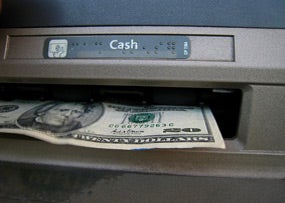 Chase announced today that it will stop charging non-Chase customers in Illinois $5 to use the bank’s ATMs. Non-customers in Texas will no longer have to pay $4 every time they use a Chase ATM.
Chase announced today that it will stop charging non-Chase customers in Illinois $5 to use the bank’s ATMs. Non-customers in Texas will no longer have to pay $4 every time they use a Chase ATM.
Instead, fees in both states will revert back to $3, the same rate Chase charges across the country, says Tom Kelly, a spokesman for the bank. That’s good news for consumers, but still leaves Chase among the more expensive banks when it comes to ATM fees, analysts say. The average ATM fee for non-bank customers is $2.33, according to David Gwidt, sales director of RateWatch.
“I think $5 is very high. And $3 is high, too,” says Beverly Blair Harzog, Credit.com’s credit card expert. “Anything above $2 is high.”
[Article: Time for a CARD Act for Checking Accounts?]
Chase began charging non-customers higher fees as part of a test that began in Texas and Illinois on Feb. 8. The drop to $3 is effective immediately, Kelly says. Chase operates the second largest ATM network in the U.S., with about 16,000 machines.
Kelly declined to say why Chase changed its fees. Some industry experts believe the test’s timing had more to do with politics than banking, however. Chase instituted the higher fees in Texas and Illinois at the height of the Congressional debate over interchange fees, which are levied each time a consumer swipes a debt card at a cash register.
The nation’s largest retailers, including 7-Eleven, have complained for years that Visa and MasterCard use their dominance of the market—together the two companies control 70% of the debit card market—to set interchange fees exorbitantly high, and pass the profits onto major banks like Chase.
“They don’t want to compete,” says Mallory Duncan, chief attorney for the National Retail Federation. “They want a cartel. They want monopoly pricing, because that’s what they have now and it’s very profitable.”
[Resource: Credit.com’s Consumer Guide to the Proposed Debit Interchange Rule]
Last year Congress passed the Durbin Amendment, which required the Federal Reserve to cap interchange fees. The Fed proposed cutting the fees from their current average of 44 cents to 12 cents, an 84% drop. That provoked howls of anger from banking industry representatives, who warned that banks would find other ways to make up the lost revenue (including ATM fee increases).
“The retailers don’t want to pay their fair share of this system,” says Trish Wexler, spokeswoman for the Electronic Payments Coalition, which represents banks and the credit card networks. “They want us, the consumer, to pay for it. And that’s not fair.”
“I think it’s safe to say that was at least partly a PR move, and also to protect themselves in a business sense in case the Durbin Amendment goes through,” Harzog says.
Image: Bill S, via Flickr.com
You Might Also Like
March 11, 2021
Personal Finance
March 1, 2021
Personal Finance
February 18, 2021
Personal Finance





